Many people use the words “antlers” and “horns” interchangeably as if they’re the same thing. They aren’t.
Occasionally I rerun a favorite older blog post. I was inspired to rerun this one, originally published nearly seven years ago, by a conversation I heard fairly recently on Antelope Island when a car pulled up behind me. Two middle-aged couples got out of the car and I could hear them discussing a small group of nearby Mule Deer. They were trying to determine if the deer were bucks or does and I could hear them repeatedly referring to buck deer as having “horns”.
The teacher in me wanted to gently correct them. I didn’t but resisting wasn’t easy. Today’s post will scratch that itch.
For this version of the post I’ve modified the title, added a photo, edited the text and tweaked the formatting.
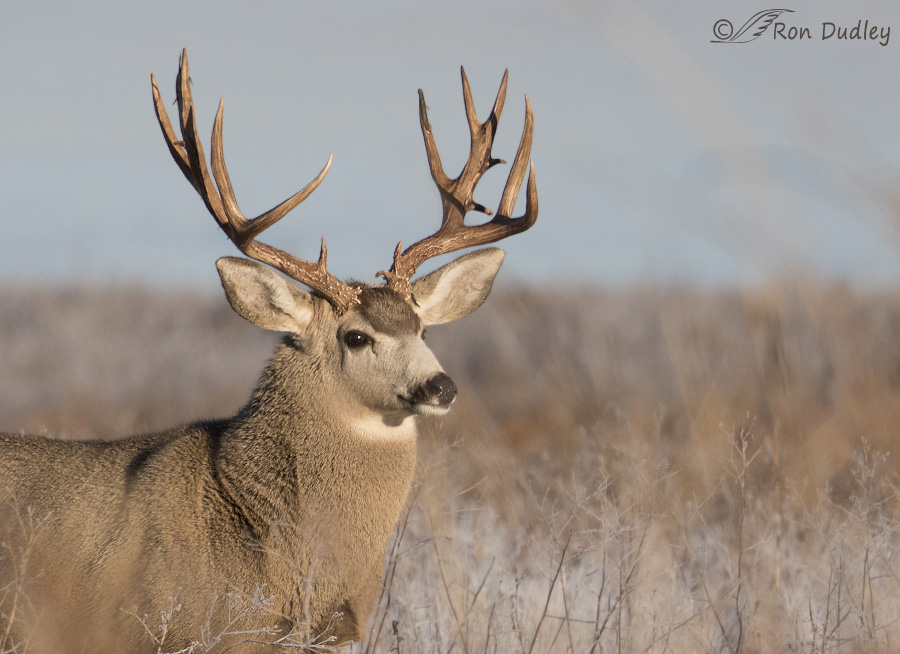
Antlers are found on members of the deer family (Cervidae) – all species of deer, moose and elk. This mule deer buck with his neck swollen for the rut has a handsome rack of antlers, not horns. To me his face looks sheep-ish, but that’s neither here nor there.
Antlers:
- are made of bone and found only on males (with the exception of caribou where females have small antlers)
- are grown every spring and shed every winter (with very few exceptions including a couple of small tropical deer species that don’t shed their antlers)
- are typically branched
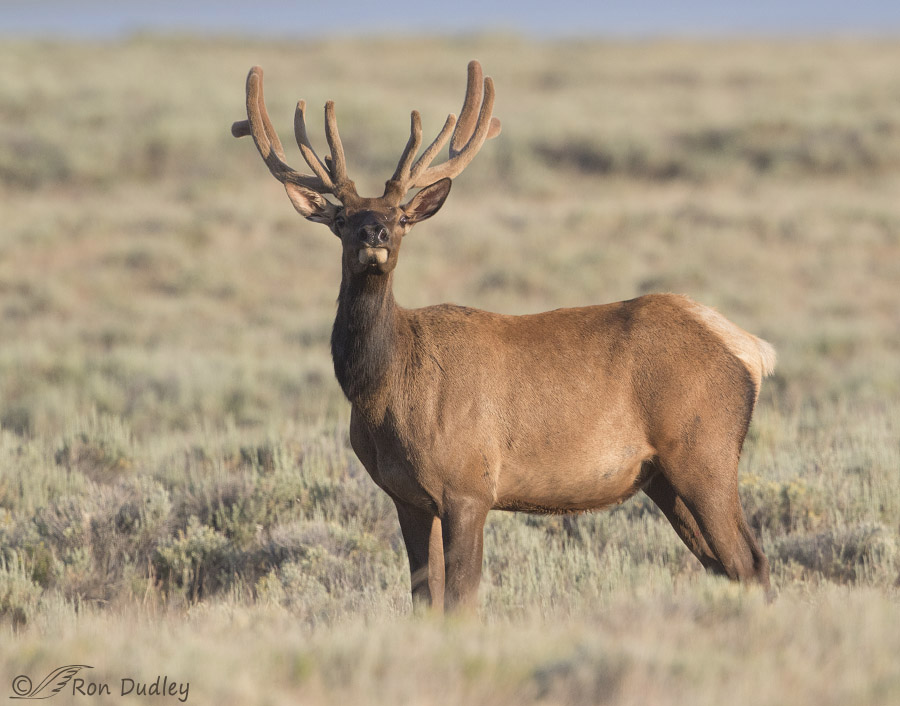
This is a bull elk whose still-growing antlers are covered in velvet which carries blood and nutrients to the growing antlers. When the antlers reach full size the velvet dies and is shed, leaving the mature antlers behind.
Horned mammals never have velvet.
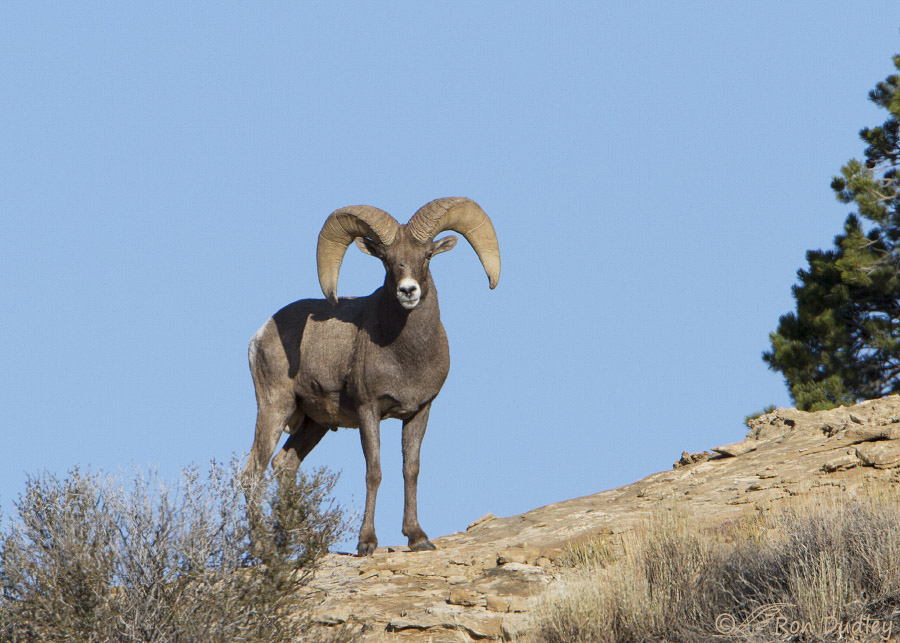
Horns are found on members of family Bovidae, the cloven hoofed ruminants, including cattle, bison, water buffalo, antelope, sheep, goats and muskoxen. I think readers will agree that this male Desert Bighorn Sheep has spectacular horns.
Horns:
- have a bony core that is covered with a thick sheath of keratin (the protein that hair, fingernails and hooves are made of). It’s the keratin that we actually see.
- most horns are never branched, are never shed and grow throughout the life of the animal
- are typically found on both males and females though they’re much smaller on females
- shape and size vary considerably
So an adult horned mammal of either sex will always have its horns while antlered mammals only have antlers in season (usually) and only on males (usually).
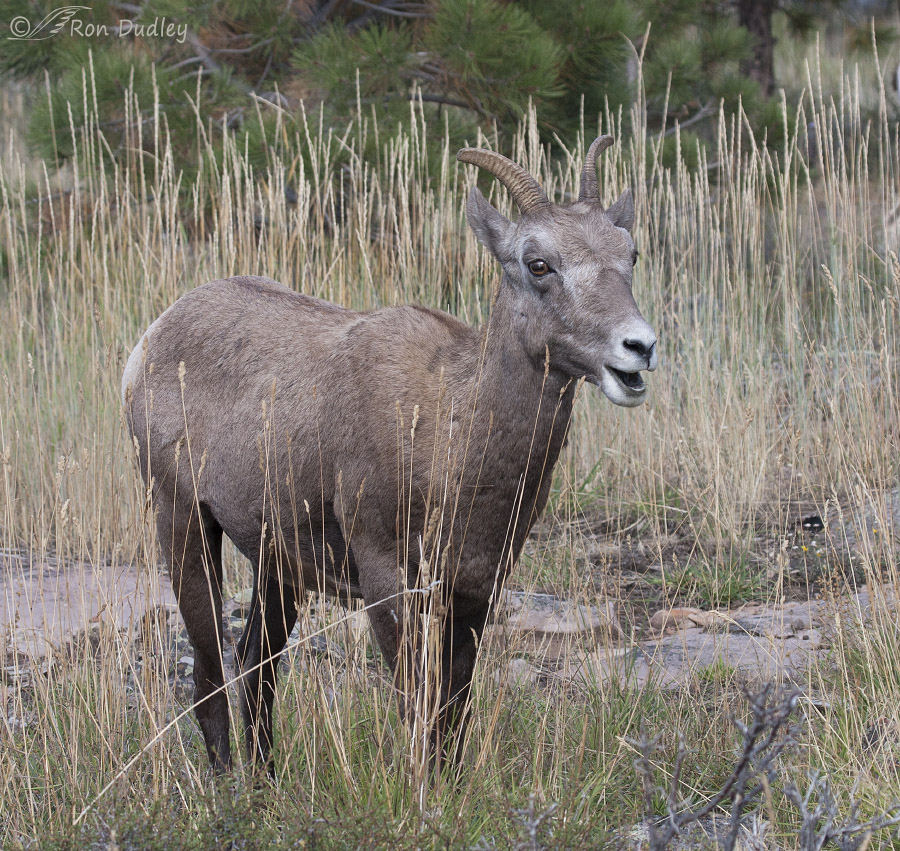
This female Mountain Bighorn Sheep is an example of a female having much smaller horns.
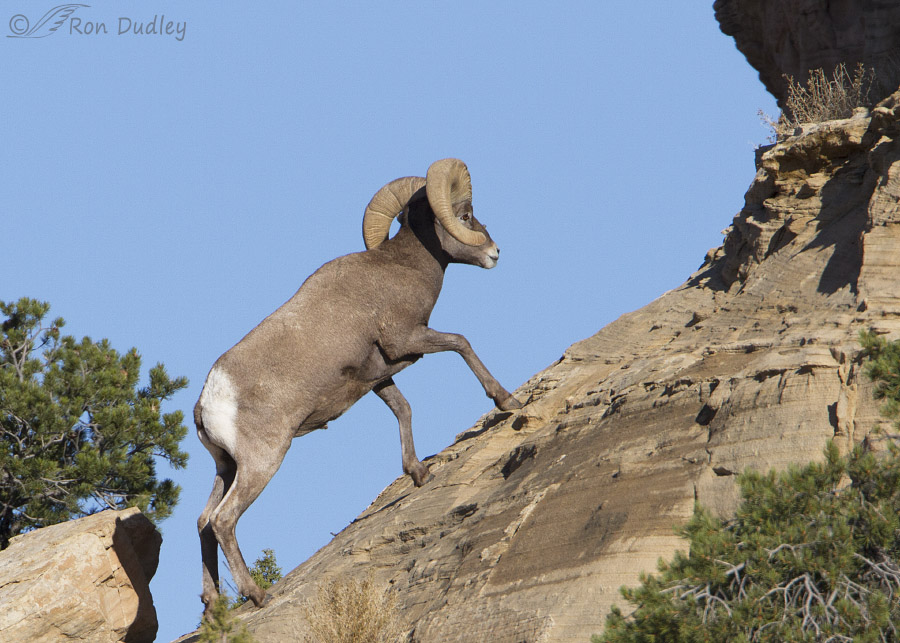
Male bighorns can actually be aged by counting the growth rings (annuli) on their horns. At this angle we can see three distinct growth rings on his left horn. Determining age accurately is just a little bit tricky but if you’re interested in how it’s done you may want to visit this link.
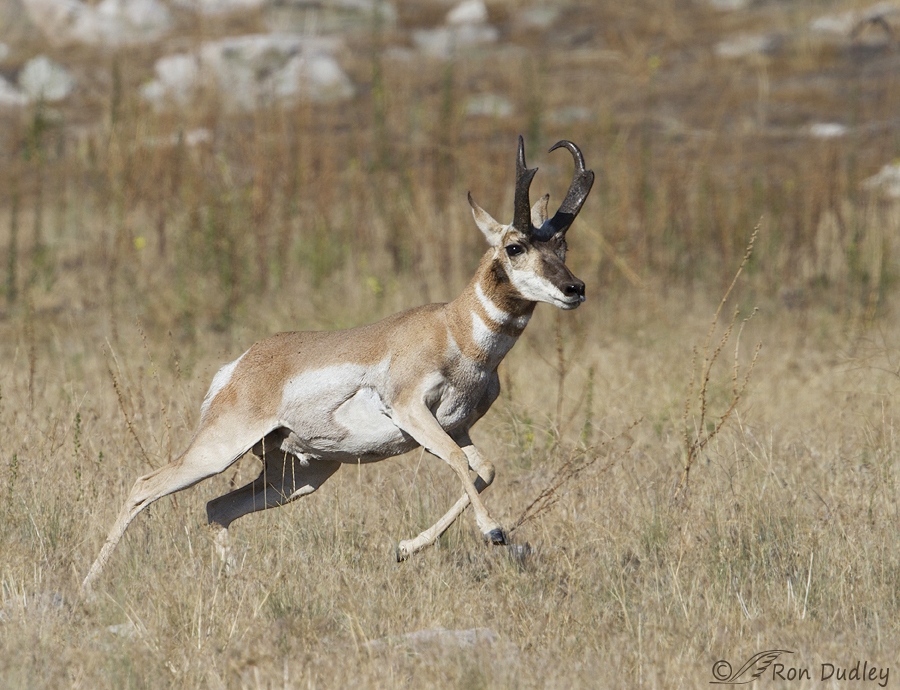
There are a few minor exceptions to some of the “rules” I’ve provided above and the Pronghorn is one of them. Pronghorns have horns (made of keratin) but like antlers they’re shed annually and regrown, leaving the bony core behind in the interim. Pronghorns are the only mammals to have branched horns.
Pronghorns are commonly and incorrectly called antelope (witness Antelope Island and Home On The Range – “where the deer and the antelope play”) but they aren’t at all closely related to true antelope which are all native to the Old World. Pronghorns are the only surviving members of family Antilocapridae and their closest living relatives are the giraffes and okapi of Africa.
Then there are animals that don’t neatly fit either definition very well. Giraffes have ossicones – made of ossified cartilage covered with skin. The horns of rhinos are made completely out of keratin – no bone. Some horned lizards have true horns with a bony core, while the “horns” of other horned lizards are made of specialized body scales with no bone.
To make things even more confusing, sometimes horns and antlers are deformed for various reasons and don’t fit any logical description regarding shape.
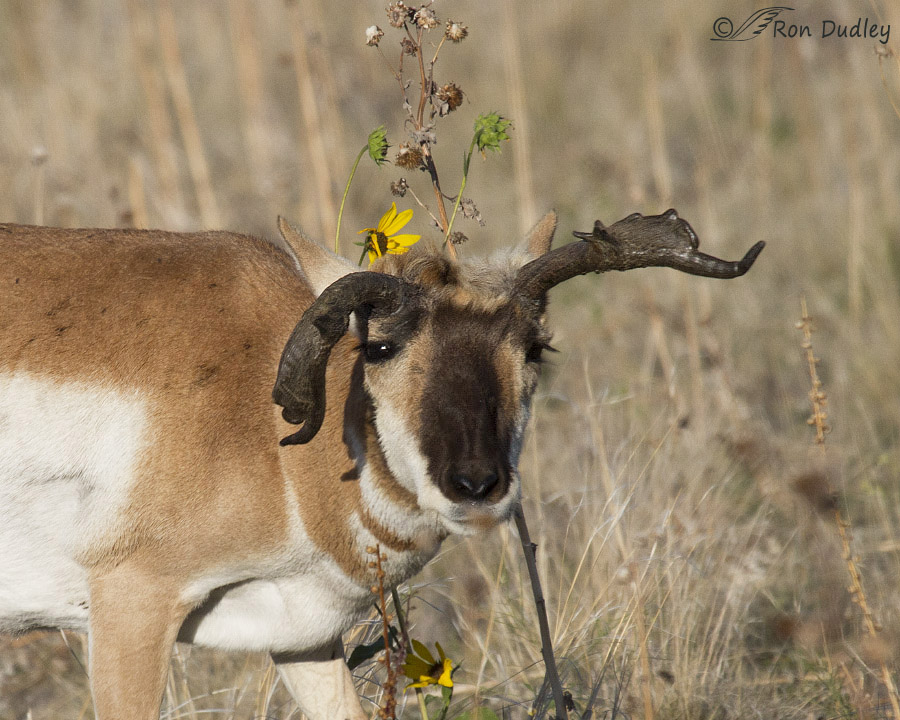
This buck Pronghorn roamed Antelope Island for several years and became almost famous amongst my friends and acquaintances who are bird and wildlife photographers. He had the most screwed up horns I’ve ever seen on any mammal. I affectionately called him Curlicue, but I know others who called him Twisty. It was always a good day on the island when I found Curlicue.
OK, I’ve probably beaten this antler vs. horn thing to death but that distinction has always been an important one for me. Anyone who ever took my Utah wildlife or zoology classes at South High School and then Highland High School definitely knew the difference(s) before they passed my class.
Ron


Glad you got to scratch that itch with us. I completely understand the feeling of wanting to capture that “teachable moment” out in public.
You can take the teacher out of the classroom…
I’ve been remiss in feeding my poor brain any interesting new info, so your post has made me very happy. I only vaguely knew the difference between antlers and horns and now I know so much more. I was amazed by the “swollen” neck of the male mule deer in rut and details about the pronghorn. And thank you for my new swear word
“anal sphincter”.
I was fortunate to see a presentation at Rocky Mountain National Park last year. The ranger had a set of elk antlers that we could touch and hold. I was surprised at how lightweight they were given their mass. I am curious about the weight of horns–they look plenty hefty particularly when the rams fight.
Linda, the actual horns (the keratin) are relatively light. Think of fingernails. Or hooves. But of course that doesn’t include the bony core, which is heavier.
Thanks teach. I do appreciate your lessons. And both horns and antlers. There seem to be plenty of exceptions to this rule though…
Yup, lots of exceptions EC. Including some I didn’t mention. Thanks.
Appreciate this! Learned something this morning. Thanks!
Good. Thank you, Susan.
Curlicue is adorable!! Having grown up in Alaska and now living half the year in the AZ White Mountains – have experienced ‘Antler Hunting’ my whole life. So many artists love to create interesting pieces with Antlers. Horns …. stay away from animals with horns(!) although who doesn’t love a Bighorn sighting. They are beautiful animals and make mountain climbing look simple! Nice post today Ron
I’m glad you enjoyed it, Kathleen. Thanks.
A great collection of information here! Thanks for the post Ron.
Thanks very much, Bill.
Wonderful post. Knew the horn/antler bit, but did not know about giraffe ossicones. What a name! Thanks for the lecture!
Thanks, Sallie. I guess it was a lecture but it scratched my itch.
Excellent biology lesson this morning Ron. One of the things I have great interest in today, but had no interest as a high school student when I should have. Like Judy, I have always known the difference between horns and antlers, but only on the surface, never to the depth you explain here. Laughing that you did not walk over and correct those people, I have done that myself a few times when I have heard people saying something incorrect about animal or birds or places etc. If done politely and diplomatically most people are receptive. Have always laughed at locations incorrectly named such as Antelope Island when we do not have antelopes here in the US. Of course they named it for the Pronghorns who as you did point out here are not antelopes. Very interesting post.
“most people are receptive.”
The operative word there is “most”, Everett. You never know when one of them is going to be an anal sphincter about it so I’m no longer willing to chance it. The less tension in my life the better.
Knew “horns” and “antlers” were different tho not the biological particulars….. Remember hearing that Pronghorns are not Antelope but hadn’t thought about it – Joe was aware of that. He refers to them as “goats”. Know their bambi’s are MUCH harder to deal with than deer bambi’s – Fish and Game doesn’t like dealing with them. Generally a waste of time to correct folks on it and yes, hunters are not immune from incorrect labels….
Remember hearing that Pronghorns are not Antelope but hadn’t thought about it – Joe was aware of that. He refers to them as “goats”. Know their bambi’s are MUCH harder to deal with than deer bambi’s – Fish and Game doesn’t like dealing with them. Generally a waste of time to correct folks on it and yes, hunters are not immune from incorrect labels….
“Darlin’ Deer” are REALLY on my list as, besided the flower garden, they had to come sample my outside potted plants last night sometime and “fine dog” didn’t say boo!
Judy, your last five words had me laughing out loud. Thanks for that.
Got it…as long as there will be no test.
Then how will we ever know…
Your tests were always great ones. You made the class fun and easy to study for the tests. Because of your class, I have always remembered the difference between the two.
Your comment made my day, Juliannah. Thanks very much.
That was very educational Ron. I already knew some of the material, but learned some biology that only could come from a true educator. That poor antelope looked so undignified. There was a buck antelope that lived on Norm Johnson’s farm that had been hit by a car when he was a fawn and when he matured one of his horns grew out the side of his skull. It looked odd. We referred to him as the bent horned buck.
Thank you, Ron! I rarely respond but always read and appreciate your posts. The pictures say so much! We live in the forest in New England and often have deer in our yard often as well as many other creatures. Luckily not many bears!
Thanks, Mary. If I lived in the forest, having bears around would be the icing on the cake. I know, easy for me to say…
I’m so glad that you re-published this post, because I hadn’t seen
the original, and DEFINITELY was ignorant of the differences….
I wonder why the female Bighorn sheep evolved with horns ( I’m
assuming that in most species males have horns for “dueling ” and
display related to combat and territorial purposes ? )while females
usually don’t have them….do female Pronghorns have horns ? Poor
“Curlicue”– I wonder if the other Pronghorns “laughed and called him
names”, like Rudolph ?
Kris, female pronghorns have horns but they’re just small spikes.
Your last sentence made me smile.
I hope that I would have asked the couple “Do you want to know the difference between horns, and the antlers that those deer have?” That is, don’t start lecturing, but make an offer that they might appreciate.
I happen to know the difference, because my family used to hunt deer. But I did not know pronghorns were (somewhat) related to giraffes.
Different strokes, Cheryl. I’ve had folks take offense when I’ve gently offered correct info, without lecturing, so I don’t do it anymore.
And I’ve known “hunters” who don’t know the difference.
Wonderful post! I appreciate the education and I love Curlicue!!
Much appreciated, Joanne. I was pretty fond of him too. Still am, though I’m pretty sure he’s gone to that prairie in the sky. It’s been years since I’ve seen him.